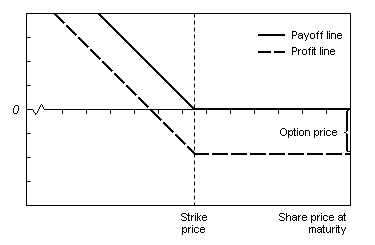Buying
a put option
A put
option (sometimes simply called a "put") is a financial
contract between two parties, the buyer and the writer (seller)
of the option. The put allows the buyer the right but not
the obligation to sell a commodity or financial instrument
(the underlying instrument) to the writer (seller) of the option
at a certain time for a certain price (the strike price). The
writer (seller) has the obligation to purchase the underlying
asset at that strike price, if the buyer exercises the option.
This
is a graphical interpretation of the payoffs and profits
generated by a put option as seen by the buyer
of the option. A lower stock price means a higher
profit.

Eventually, the price of the underlying security will
be low enough to fully compensate for the price of
the option.
Writing
a put option - This is a graphical interpretation
of the payoffs and profits generated by a put
option as seen by the writer of the option. Profit
is maximized when the price of the underlying security
exceeds the strike price, because the option expires
worthless and the writer keeps the premium.

Note that
the writer of the option is agreeing to buy the underlying
asset if the buyer exercises the option. In exchange for having
this option, the buyer pays the writer (seller) a fee (the premium).
(Note: Although option writers are frequently referred to as
sellers, because they initially sell the option that they create,
thus taking a long position in the option, they are not the
only sellers. An option holder can also sell his short position
in the option. However, the difference between the two sellers
is that the option writer takes on the legal obligation to buy
the underlying asset at the strike price, whereas the option
holder is merely selling his short position, and is not contractually
obligated by the sold option.)
Exact specifications
may differ depending on option style. A European put option
allows the holder to exercise the put option for a short period
of time right before expiration. An American put option allows
exercise at any time during the life of the option.
The most
widely-known put option is for stock in a particular company.
However, options are traded on many other assets: financial
- such as interest rates (see interest rate floor) - and physical,
such as gold or crude oil.
The put
buyer either believes it's likely the price of the underlying
asset will fall by the exercise date, or hopes to protect a
long position in the asset. The advantage of buying a put over
shorting the asset is that the risk is limited to the premium.
The put writer does not believe the price of the underlying
security is likely to fall. The writer sells the put to collect
the premium. Puts can also be used to limit portfolio risk,
and may be part of an option spread.
Example
of a put option on a stock
Buy a Put: Ty Eriksen thinks price of a stock will decrease.
Pay a premium which buyer will never get back.
The buyer has the right to sell the stock
at strike price.
Write a put: Writer receives a premium.
If buyer exercises the option,
writer will buy the stock at strike price.
If buyer does not exercise the option,
writer's profit is premium.
- 'Trader
A' (Put Buyer) purchases a put contract to sell 100
shares of XYZ Corp. to 'Trader B' (Put Writer) for
$50/share. The current price is $55/share,
and 'Trader A' pays a premium of $5/share. If the
price of XYZ stock falls to 40/share right before
expiration, then 'Trader A' can exercise the put by buying
100 shares for $4,000 from the stock market, then selling
them to 'Trader B' for $5,000.
Trader A's total earnings (S) can be calculated at $500.
Sale of the 100 stock at strike price of $50 to 'Trader B' = $5,000 (P)
Purchase of 100 stock at $40 = $4,000 (Q)
Put Option premium paid to Trader B for buying the contract of 100 shares @ $5/share, excluding commissions = $500 (R)
S=P-(Q+R)=$5,000-($4,000+$500)=$500
- If, however,
the share price never drops below the strike price (in this
case, $50), then 'Trader A' would not exercise the option.
(Why sell a stock to 'Trader B' at $50, if it would cost 'Trader
A' more than that to buy it?). Trader A's option would be
worthless and he would have lost the whole investment, the
fee (premium) for the option contract, $500 (5/share,
100 shares per contract). Trader A's total loss are limited
to the cost of the put premium plus the sales commission to
buy it.
This example illustrates that the put option has positive monetary
value when the underlying instrument has a spot price (S)
below the strike price (K). Since the option will
not be exercised unless it is "in-the-money", the payoff for
a put option is
- max[(K ŌłÆ S) ;
0] or formally, (K ŌłÆ S) +
- where :

Prior to
exercise, the option value, and therefore price, varies with
the underlying price and with time. The put price must reflect
the "likelihood" or chance of the option "finishing in-the-money".
The price should thus be higher with more time to expiry, and
with a more volatile underlying
instrument. The science of determining this value is the central
tenet of financial mathematics. The most common method is to
use the Black-Scholes formula. Whatever the formula used, the
buyer and seller must agree on this value initially.
See
also
External
links

